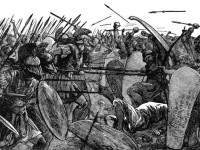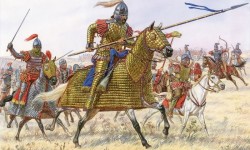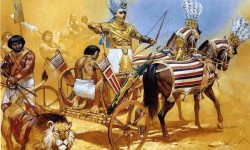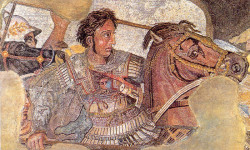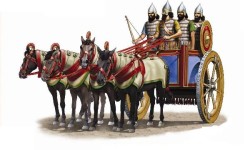The clashes between the Greek city-states and the Persians are more than known since the films "300" and "300 Rise of an Empire". Against a crushing superiority, the Greeks fought at Marathon, Thermopylae and Salamis and proved their courage and skill.
But not only the Greek courage came to the fore at the time, also the tactical insertion of units like the Greek phalanx to weaken the enemy superiority came to light here.
The former dominion of the Persian king Darius I from 522 to 486 BC already extended over many Greek city-states. The previous rulers had already incorporated Anatolia and the east coast of the Aegean into the Persian empire. At the beginning of the 5th century BC, an open revolt of the Ionian cities against Persian rule occurred for the first time, whereupon Dareios used his army for suppression. When the Persians demolished the city-state of Miletus as a ringleader of the revolt in 494 BC and carried off the population, they continued their campaign of conquest and extended it to the Aegean islands and the Greek mainland. After the city-states of Athens and Sparta rejected the subjugation, it came a few years later to the well-known battle between the Spartiaten and the Persern under the guidance Xerxes.
But before the known battle passed 4 years of preparation by the Persians. In these years, among other things by the isthmus at Athos specially for the Persian fleet dug a channel around the stormy cape in the Aegean Sea to be able to drive around. In 480 BC, the invasion then took place in the rest of Greece, with the 200,000-strong Persian army marching along the coast towards Athens. At the narrow pass of Thermopylae they also met the Spartans, who had to oppose the Persian army for 3 days before it could defeat the Spartans by betrayal. Without further resistance, the Persian army was now able to march on towards Athens, where it severely destroyed and looted the city on arrival. Through a tactical retreat to the south, at least the Athenian forces and the fleet could be rescued in Peloponnese to later at the Battle of Salamis to beat the Persian naval fleet by using the ramming spurs of the Greek Trier.
Humiliated, Xerxes then surrendered the command to Mardonios, who was crushed in July 479 BC by a merger of the Greek allies and the Persian invasion had failed.
You can find the right literature here:
From Cyrus to Alexander: A History of the Persian Empire
Around 550 B.C.E. the Persian people—who were previously practically unknown in the annals of history—emerged from their base in southern Iran (Fars) and engaged in a monumental adventure that, under the leadership of Cyrus the Great and his successors, culminated in the creation of an immense Empire that stretched from central Asia to Upper Egypt, from the Indus to the Danube. The Persian (or Achaemenid, named for its reigning dynasty) Empire assimilated an astonishing diversity of lands, peoples, languages, and cultures. This conquest of Near Eastern lands completely altered the history of the world: for the first time, a monolithic State as vast as the future Roman Empire arose, expanded, and matured in the course of more than two centuries (530–330) and endured until the death of Alexander the Great (323), who from a geopolitical perspective was “the last of the Achaemenids.” Even today, the remains of the Empire-the terraces, palaces, reliefs, paintings, and enameled bricks of Pasargadae, Persepolis, and Susa; the impressive royal tombs of Naqsh-i Rustam; the monumental statue of Darius the Great-serve to remind visitors of the power and unprecedented luxury of the Great Kings and their loyal courtiers (the “Faithful Ones”).
Though long eclipsed and overshadowed by the towering prestige of the “ancient Orient” and “eternal Greece,” Achaemenid history has emerged into fresh light during the last two decades. Freed from the tattered rags of “Oriental decadence” and “Asiatic stagnation,” research has also benefited from a continually growing number of discoveries that have provided important new evidence-including texts, as well as archaeological, numismatic, and iconographic artifacts.
The evidence that this book assembles is voluminous and diverse: the citations of ancient documents and of the archaeological evidence permit the reader to follow the author in his role as a historian who, across space and time, attempts to understand how such an Empire emerged, developed, and faded. Though firmly grounded in the evidence, the author’s discussions do not avoid persistent questions and regularly engages divergent interpretations and alternative hypotheses. This book is without precedent or equivalent, and also offers an exhaustive bibliography and thorough indexes.
The Persians: Ancient, Mediaeval and Modern Iran
In recent years, Iran has gained attention mostly for negative reasons—its authoritarian religious government, disputed nuclear program, and controversial role in the Middle East—but there is much more to the story of this ancient land than can be gleaned from the news. This authoritative and comprehensive history of Iran, written by Homa Katouzian, an acclaimed expert, covers the entire history of the area from the ancient Persian Empire to today’s Iranian state.
Writing from an Iranian rather than a European perspective, Katouzian integrates the significant cultural and literary history of Iran with its political and social history. Some of the greatest poets of human history wrote in Persian—among them Rumi, Omar Khayyam, and Saadi—and Katouzian discusses and occasionally quotes their work. In his thoughtful analysis of Iranian society, Katouzian argues that the absolute and arbitrary power traditionally enjoyed by Persian/Iranian rulers has resulted in an unstable society where fear and short-term thinking dominate. A magisterial history, this book also serves as an excellent background to the role of Iran in the contemporary world.
History of the Persian Empire
Out of a lifetime of study of the ancient Near East, Professor Olmstead has gathered previously unknown material into the story of the life, times, and thought of the Persians, told for the first time from the Persian rather than the traditional Greek point of view.
The Persian Empire: A Captivating Guide to the History of Persia, Starting from the Ancient Achaemenid, Parthian, and Sassanian Empires to the Safavid, Afsharid, and Qajar Dynasties

The Persian Empire: A Captivating Guide to the History of Persia, Starting from the Ancient Achaemenid, Parthian, and Sassanian Empires to the Safavid, Afsharid, and Qajar Dynasties Paperback – December 11, 2018
Students of ancient history are well aware of the Persians. A still-present cultural and linguistic group, the Persians are the founders of today’s modern-day nation of Iran. They trace their roots back to the Aryans of Northern Europe, but over the course of time, they managed to assert a distinct identity that led to the formation of some of the world’s most powerful empires.
One of the most shocking things about the Persians is how quickly they went from an obscure, powerless, and nomadic tribe to an immense empire that spanned across western Asia, Africa, and parts of Europe. The rise of Cyrus the Great, considered the father of Persia, in the 7th century BCE, filled the power vacuum caused by the fall of the Assyrians, and it led to the formation of one of the most powerful empires of the ancient world.
The Persians have made significant contributions to world culture, ranging from their ability to raise and train one of the ancient world’s most formidable fighting forces, the Persian Immortals, to their new and effective ways of organizing and administering government. And Persian art heavily influenced their Muslim invaders, helping to usher in the Islamic Golden Age that helped spread Islam throughout the Middle East and Africa.
This post is also available in:
 Deutsch (German)
Deutsch (German)  Français (French)
Français (French)  Italiano (Italian)
Italiano (Italian)  简体中文 (Chinese (Simplified))
简体中文 (Chinese (Simplified))  Русский (Russian)
Русский (Russian)  Español (Spanish)
Español (Spanish)  العربية (Arabic)
العربية (Arabic)

